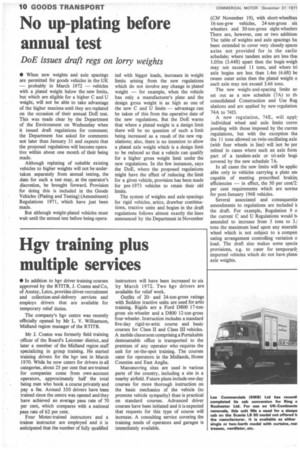No up-plating before annual test
Page 12

If you've noticed an error in this article please click here to report it so we can fix it.
DoE issues draft regs on lorry weights
• When new weights and axle spacings are permitted for goods vehicles in the UK — probably in March 1972 — vehicles with a plated weight below the new limits, but which are eligible for a higher C and U weight, will not be able to take advantage of the higher maxima until they are replated on the occasion of their annual DoE test. This was made clear by the Department of the Environment on Wednesday when it issued draft regulations for comment; the Department has asked for comments not later than January 31 and expects that the proposed regulations will become operative within about one month of their being made.
Although replating of suitable existing vehicles to higher weights will not be undertaken separately from annual testing, the date for such a test may, at the operator's discretion, be brought forward. Provision for doing this is included in the Goods Vehicles (Plating and Testing) (Amendment) Regulations 1971, which have just been made.
But although weight-plated vehicles must wait until the annual test before being opera ted with bigger loads, increases in weight limits arising from the new regulations which do not involve any change in plated weight — for example, when the vehicle has only a manufacturer's plate and the design gross weight is as high as one of the new C and U limits — advantage can be taken of this from the operative date of the new regulations. But the DoE warns that where a plated weight is a design limit there will be no question of such a limit being increased as a result of the new regulations; also, there is no intention to allow a plated axle weight which is a design litnit to be reduced so that a vehicle can qualify for a higher gross weight limit under the new regulations. In the few instances, says the DoE, where the proposed regulations might have the effect of reducing the limit for a given vehicle, provision has been made for pre-1973 vehicles to retain their old limits.
The system of weights and axle spacings for rigid vehicles, artics, drawbar combinations, tractive units and bogies in the draft regulations follows almost exactly the lines announced by the Department in November (CM November 19), with short-wheelbas 16-ton-gvw vehicles, 24-ton-gross six wheelers and 30-ton-gross eight-wheeler There are, however, one or two addition The table of weights and axle spacings ha been extended to cover very closely space( axles not provided for in the earlie schedule; where tandem axles are less thai 1.05m (3.44ft) apart then the bogie weigh may not exceed 11 tons, and where tri axle bogies are less than 1.4m (4.6ft) be tween outer axles then the plated weight o each axle may not exceed 3.66 tons.
The new weight-and-spacing limits arl set out as a new schedule (7A) to th consolidated Construction and Use Reg ulations and are applied by new regulation 74A to 74D.
A new regulation, 74E, will appl] individual wheel and axle limits corre: ponding with those imposed by the curren regulations, but with the exception tha the 11 tons allowed on twin-oscillating axle (with four wheels in line) will not be per mitted in cases where such an axle form part of a tandem-axle or tri-axle bogii covered by the new schedule 7A.
In all cases the new limits will be applic able only to vehicles carrying a plate am capable of meeting prescribed brakin efficiencies — in effect, the 50 per cent/2: per cent requirements which are norma for post-January 1968 vehicles.
Several associated and consequentia amendments to regulations are included the draft. For example, Regulation 9 o the current C and U Regulations would b amended to increase from 3 tons to 3J tons the maximum load upon any steerabli wheel which is not subject to a compen sating arrangement controlling variation o load. The draft also makes some specia provisions, e.g. to cater for temporaril] imported vehicles which do not have plate( axle weights.












































































